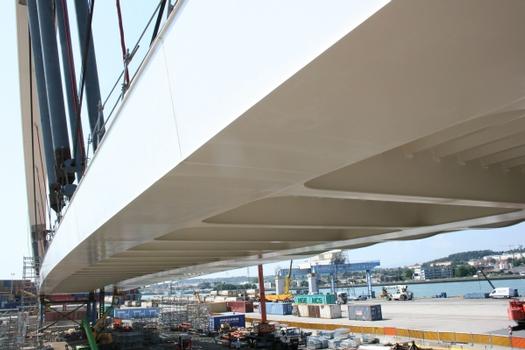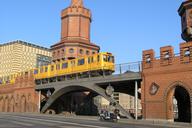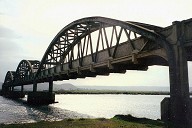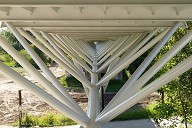The white arc over the Rhone river
Since 4 September 2013 it is there: the great white arc over the Rhone river in Lyon. What optically almost floats posed an enormous challenge in technical respect, because the steel arc bridge which caters for pedestrians, bicycles and a tram, had to be safeguarded against uplift forces. Maurer Söhne had the solution with uplift bearings of a design that was used earlier in German railway bridges.
The reason for the construction of the Raymond Barre Bridge is a trivial one: extension of the tram line 1 from Montrochet to Debourg. However this bridge is a spectacular sight even for the multi-bridge-city of Lyon. The bridge is located near the confluence of the Rhone and Saone River – exactly there where the "Musée de Confluences" of the Viennese architect Coop Himmelb(l)au will be located, and directly next to the Pont Pasteur, which accommodates the traffic into the city in 4 lanes. The bridge is named after the former prime minister and lord mayor of Lyon, Raymond Barre. Architect is the Parisian Alain Spielmann.
Bridge construction on the mainland
The bridge structure is 260 m long and 17.50 m high. The main bridge employs a main span of 150 m. Due to the fact that the Rhone river has lots of ship traffic, the bridge was not erected on site, but at about a distance of 1 km next to the container port of Lyon. The eastern ramp was erected in situ. This ramp reaches out to the Rhone river in a curve, and the geometry of the ramp leads to uplift forces in two bridge bearings. Therefore, 2 of the 10 bearings which were supplied by Maurer Söhne were designed as uplift bearings.
Calotte-in-Calotte-System
MAURER uplift bearings facilitate the transfer of both tension (i.e. uplift) and compression forces in any state of rotation and displacement. By way of the high performance sliding material MSM® also in the contact surfaces the displacements of the structure which occur in case of uplift can be accommodated without constraints and repeatedly. MAURER uplift bearings are suitable for complex roof structures and bridge structures with high variable load components and high structural displacements, e.g. in case of railway bridges. Next to the two uplift bearings, a further 8 spherical bearings were installed. All of them contain the sliding material MSM®. And in case of demanding bridge bearings, this material proves again and again its superior performance: MSM® can accommodate high contact pressures, sliding displacements and displacement velocities. It is adaptable, which means that the 2 mating partners can neatly nestle against each other, and yet it demonstrates a long service life. All bridge bearings were only installed at their supporting locations after the main bridge and the west bridge were transported to the site.
The bridge structure was floated into position in the night from the 3rd to the 4th of September, which turned out to be a highly complex affair. Elevating trucks transported the steel structure onto the barges and were then transported around 1 km upstream. The provisory placement on the prefabricated piers and abutments was carried out with as much diligence as possible. Cause the elevating trucks were standing onto the barges, the bridge structure could not be decoupled from the waterflow of the Rhone river.
Anyhow, the placement was successful. While the future tram will commute between 2 white arches over the bridge, the bikers and the pedestrian cross the bridge on a platform which kind of floats like a cantilever over the Rhone river. In addition, a large viewing point is being prepared, from which a first class view can be cast at the spectacular architecture of the Musée Confluences. The bridge was opened for traffic in 2014.
References
Structure Types
- About this
data sheet - Product-ID
7056 - Published on:
27/01/2014 - Last updated on:
19/05/2017



 MAURER SE
MAURER SE 



